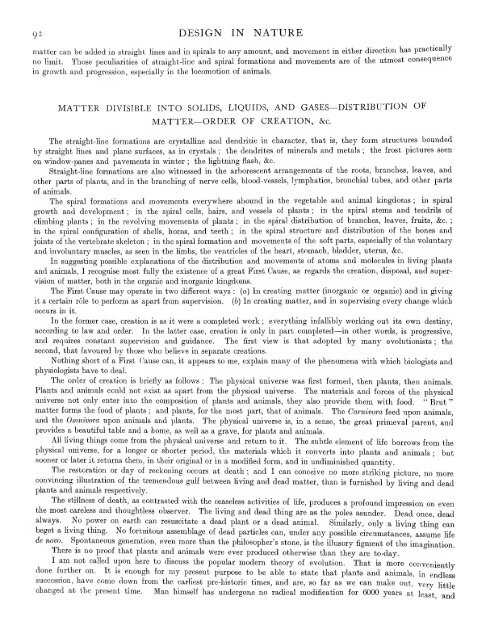You also want an ePaper? Increase the reach of your titles
YUMPU automatically turns print PDFs into web optimized ePapers that Google loves.
92 DESIGN IN NATURE<br />
matter can be added in straight lines and in spirals to any amount, and movement in either direction has practica y<br />
no limit. Those pecuharities of straight-line and spiral formations and movements are of the utmost consequence<br />
in growth and progression, especially in the locomotion of animals.<br />
MATTER DIVISIBLE INTO SOLIDS, LIQUIDS, AND GASES—DISTRIBUTION OF<br />
MATTER—ORDER OF CREATION, &c.<br />
The straight-line formations are crystalline and dendritic in character, that is, they form structures bounded<br />
by straight lines and plane surfaces, as in crystals ; the dendrites of minerals and metals ; the frost pictures seen<br />
on window-panes and pavements in winter ; the lightning flash, &c.<br />
Straight-Une formations are also witnessed in the arborescent arrangements of the roots, branches, leaves, and<br />
other parts of plants, and in the branching of nerve cells, blood-vessels, lymphatics, bronchial tubes, and other parts<br />
of animals.<br />
The spiral formations and movements everywhere abound in the vegetable and animal kingdoms ; in spiral<br />
growth and development ; in the spiral cells, hairs, and vessels of plants ; in the spiral stems and tendrils of<br />
chmbing plants ; in the revolving movements of plants ; in the spiral distribution of branches, leaves, fruits, &c. ;<br />
in the spiral configuration of shells, horns, and teeth ; in the spiral structure and distribution of the bones and<br />
joints of the vertebrate skeleton ; in the spiral formation and movements of the soft parts, especially of the voluntary<br />
and involuntary muscles, as seen in the limbs, the ventricles of the heart, stomach, bladder, uterus, &c.<br />
In suggesting possible explanations of the distribution and movements of atoms and molecules in living plants<br />
and animals, I recognise most fully the existence of a great First Cause, as regards the creation, disposal, and super-<br />
vision of matter, both in the organic and inorganic kingdoms.<br />
The First Cause may operate in two different ways : (a) In creating matter (inorganic or organic) and in giving<br />
it a certain role to perform as apart from supervision, (b) In creating matter, and in supervising every change which<br />
occurs in it.<br />
In the former case, creation is as it were a completed work ;<br />
everything infallibly working out its own destiny,<br />
according to law and order. In the latter case, creation is only in part completed—in other words, is progressive,<br />
and requires constant supervision and guidance. The first view is that adopted by many evolutionists ; the<br />
second, that favoured by those who believe in separate creations.<br />
Nothing short of a First Cause can, it appears to me, explain many of the phenomena with which biologists and<br />
physiologists have to deal.<br />
The order of creation is briefly as follows : The<br />
physical universe was first formed, then plants, then animals.<br />
Plants and animals could not exist as apart from the physical universe. The materials and forces of the physical<br />
universe not only enter into the composition of plants and animals, they also provide them with food. " Brut<br />
matter forms the food of plants ; and plants, for the most part, that of animals. The Carnivora feed upon arumals,<br />
and the Omnivora upon animals and plants. The physical universe is, in a sense, the great primeval parent, and<br />
provides a beautiful table and a home, as well as a grave, for plants and animals.<br />
All living things come from the physical universe and return to it. The subtle element of life borrows from the<br />
physical universe, for a longer or shorter period, the materials which it converts into plants and animals ; but<br />
sooner or later it returns them, in their original or in a modified form, and in undiminished quantity.<br />
The restoration or day of reckoning occurs at death ; and I can conceive no more striking picture, no more<br />
convincing illustration of the tremendous gulf between living and dead matter, than is furnished by living and dead<br />
plants and animals respectively.<br />
The stillness of death, as contrasted with the ceaseless activities of life, produces a profound impression on even<br />
the most careless and thoughtless observer. The hving and dead thing are as the poles asunder. Dead once, dead<br />
always. No power on earth can resuscitate a dead plant or a dead animal. Similarly, only a living thing can<br />
beget a living thing. No fortuitous assemblage of dead particles can, under any possible' circumstances, assume life<br />
de now. Spontaneous generation, even more than the philosopher's stone, is the illusory figment of the imagination.<br />
There is no proof that plants and animals were ever produced otherwise than they are to-day.<br />
I am not called upon here to discuss the popular modern theory of evolution. That is more conveniently<br />
done further on. It is enough for my present purpose to be able to state that plants and animals, in endless<br />
succession, have come down from the earliest pre-historic times, and are, so far as we can make out, very little<br />
changed at the present time. Man himself has undergone no radical modification for 6000 years at least and


